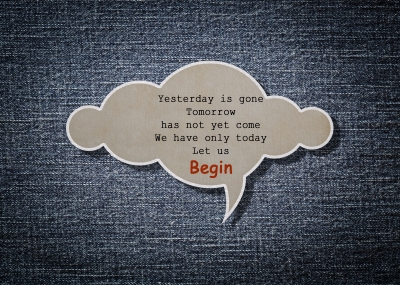 Two good posts recently at re: charity (Brady Josephson) and Future Fundraising Now (Jeff Brooks) about what charities should do today to prepare for tomorrow. Both embrace a quote from Jeff Bezos:
Two good posts recently at re: charity (Brady Josephson) and Future Fundraising Now (Jeff Brooks) about what charities should do today to prepare for tomorrow. Both embrace a quote from Jeff Bezos:
I very frequently get the question: ‘What’s going to change in the next 10 years?’ I almost never get the question: ‘What’s not going to change in the next 10 years?’ And I submit to you that that second question is actually the more important of the two — because you can build a business strategy around the things that are stable in time.
Yesterday, today and tomorrow are sort of the same.
Sounds good.
But think about this a bit more.
I agree with that it makes total sense (as it always has) to focus on (1) getting to know your donors better and (2) loving your donors more. Nonprofits tend to do a poor job of both these things, resulting in donor retention rates that are unsustainable.
But I can’t agree that you should stop worrying so much about what will change, stop trying to predict the future and instead focus on what will remain constant – knowing and caring for your supporters. I love Jeff and Brady, read their stuff all the time, and I absolutely want you to focus on these two things!
But I’m afraid you can’t stop there.
This is a case of both/and.
Yesterday, today and tomorrow are the same – and different.
It’s why three of the “Dive the Five” fundraising fundamentals I’m focusing on this year on Clairification center on the tried-and true — knowing and caring for donors in order to build mutually fulfilling, lasting relationships:
(1) major gift fundraising;
(2) donor retention, and
(3) building an organization-wide culture of philanthropy (aka an abundance of love and gratitude channeled towards your donors).
The other two, however, are focused on meeting donors (almost all of whom are part of “Generation Connected”(Gen C) where they are:
(4) integrating fundraising with a robust content-marketing strategy, and
(5) mastering online social fundraising.
Speaking of “Gen C”, did you know that the average person worldwide has five social media accounts and spends an average of 1 hour and 40 minutes browsing these networks every day? The effect of social media on nonprofit web design has been radical. If you’re not using social media actively to drive positive actions, you’re missing a huge boat.
Don’t allow the rather pessimistic philosophy of plus ça change, plus c’est la même chose blind you to the fact that change does happen. And it does matter.
Some of yesterday is very different than some of tomorrow.
In 2016 and beyond, I don’t look at becoming proficient at inbound content marketing and online social fundraising as “chasing shiny objects.”
Like it or not, technology has revolutionized business as usual. In the for-profit world and the nonprofit world. This will change in the next 10 years, no doubt. But the world is unlikely to go backwards. You must avoid becoming irrelevant in the digital age.
Of course, a lot stays the same. We’re still in a people business. But when I hear folks say “fundraising is about people, not technology,” I hear an excuse. An excuse not to do what is absolutely needed to stay relevant in the digital age. Whether you bury your head in the sand due to limited resources, lack of skills, fear of the unknown or all of the above, it’s an excuse you can ill afford.
Change is hard. You know what they say: “If it were easy, they wouldn’t call it work!” It’s work to get this right. Because there are so many different ways to communicate today that it can be dizzying!
Ground yourself by remembering that though technology has changed, people have not. They have the same drives… needs… yearnings as prehistoric tribes. They long for connection and meaning. They want to find where they “fit.”
Philanthropy provides that “fit opportunity” in spades (or, more aptly, in hearts). You’ve got the goods; you just need to tinker with your delivery system.
So, for now, I’m going to suggest you focus on one more thing:
Integrate your marketing and fundraising now!
For some time now I’ve been saying fundraising has changed more in the past 5 – 10 years than in the previous 50. In fact, I’ve been a broken record on the essential need to integrate marketing and fundraising.
Because of the digital revolution.
There’s no more room for siloes. If you want to build and sustain support for your cause then fundraising… marketing… sales… website… social media… these cannot be separate departments any longer. Frankly, they should never have been separated.
I’m happy to report that others are joining me in seeing that the digital revolution truly represents a sea change in how nonprofits do business. In a recent article on Gail Perry’s blog, Time to Change the Way You Communicate With Donors: From Multichannel to Omnichannel Communications, Margaret Battistelli Gardner, former editor of Fundraising Success, writes eloquently on the one area of nonprofit management where this change is most pronounced.
She offers a new buzzword for this area of transformation: “omnichannel communications.”
Conceptually it’s different than multi-channel. The way I see it, it boils down to this:
Marketing and fundraising are not different.
Some folks say the two are like peanut butter and jelly. They go together. I say “no.” They’re the same thing. The two functions are bound at the hip. They’re symbiotic. One bolsters the other; and vice-versa. They live together; they die alone.
Margaret and I agree in spades is that it’s beyond time for an evolution –an intentional, overarching integration— in the way nonprofits communicate with supporters: “Like it or not, fundraising IS marketing.”
Boundaries are blurring. You’ve got to integrate all online and offline communications functions across your entire organization.
How can you raise money for your cause if no one knows about the good work you’re doing?
You can’t.
Do you know how often people tell me “If folks just knew about us, they’d love what we’re doing.” Bingo!
But you can’t sit around waiting for the “marketing folks” or the “sales team” to make people aware. We’re all part of the same fundraising/marketing/sales team. And it’s all the same stuff. More or less.
One of my favorite books is Daniel Pink’s To Sell is Human. His premise is that we’re all in “sales” on a daily basis. Whether it’s simply trying to get your kids up and out the door in the morning or persuading your boss to give you a raise, you’re constantly coaxing people to induce a specific desired behavior.
And this is exactly what marketing and fundraising is all about.
As Margaret notes: “Where consumer marketers are selling a product or a service, nonprofit marketers are selling opportunity — the opportunity to change the world; the opportunity to leave a legacy; the opportunity to hedge our bets on the karmic scale.”
Marketing. Fundraising. Sales. Think of them as synonyms for today and tomorrow.
In the context of nonprofit communications, that’s exactly what they are. They all have the same goal – to influence and persuade folks to do something positive to make the world a better place.
And the way the marketplace gets this done – and, yes, the way we talk with our donors in order to persuade them to join our cause – is changing so fast your head should be spinning. If it’s not, you’re not paying attention.
So go ahead and focus on knowing and caring for your donors better. But also focus on tinkering with the way you deliver meaning to your constituents. Remember: When it comes to building lasting relationships, it pays to be social. Today more than ever.
A Sentiment for all Seasons: Gratitude!

How to keep and upgrade more donors through the active practice of gratitude + tons of creative ways to say thank you.
Cultivate an Attitude of Gratitude and Keep Your Donors. This donor thank-you “bible” is packed with the theory and practice of gratitude, one of the most effective yet least effectively utilized donor retention strategies.Thanking donors should be fun and fulfilling. Get this Special Guide here and start spreading that attitude of gratitude around. It will come right back to you!
Image courtesy of freedigitalphotos.net
-
Pingback: 12 Friends You Absolutely Need to Boost Online Fundraising, Part 2 - NonProfit PRO
-
Pingback: Nonprofits & IoT: Voice-Activated Fundraising Anyone? - NonProfit PRO





